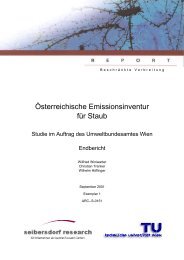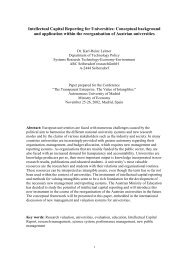ALPMON FINAL REPORT - ARC systems research
ALPMON FINAL REPORT - ARC systems research
ALPMON FINAL REPORT - ARC systems research
You also want an ePaper? Increase the reach of your titles
YUMPU automatically turns print PDFs into web optimized ePapers that Google loves.
Contract ENV4-CT96-0359 <strong>ALPMON</strong><br />
Table 9: Classification results assessed by the customer in the feasibility study<br />
Classification results Categories Comments<br />
(1) Tree species composition and � forest: larch, alder, pure pine, mixed Region Il Fuorn<br />
grassland type classification<br />
conifers<br />
� grassland types: lowland, highland, over<br />
silicate, over carbonate<br />
� water<br />
� rock, gravel, soil<br />
� sealed surface<br />
� no data (snow)<br />
(2) Forest crown cover classification � forest: disperse stand, middle dense Region Il Fuorn<br />
stand, dense stand<br />
and Val Trupchun<br />
� grassland<br />
� water<br />
� rock, gravel, soil<br />
� sealed surface<br />
� no data (snow)<br />
(3) NDVI grassland<br />
(~ phytomass estimation)<br />
� NDVI calculation of grassland Entire SNP<br />
(4) Forest crown cover and � forest: disperse stand, middle dense Entire SNP<br />
grassland type classification<br />
stand, dense stand<br />
� grassland type: disperse coverage (little<br />
phytomass), middle dense coverage,<br />
dense coverage (high phytomass)<br />
� water<br />
� rock, gravel, soil<br />
� sealed surface<br />
� no data (snow)<br />
2.3.5.4 Results<br />
The Swiss National Park has visually checked the classification results (Table 9) delivered to them in<br />
different parts of the park and has responded positively over the use and applicability of classified<br />
remote sensing data. The results have been implemented in the analysis of various mountain ungulate<br />
<strong>research</strong> projects and diploma theses. The analysis of the integration of these satellite classification<br />
results 1 and 2 (Table 9) has not been completed by our customer, as the work is still ongoing.<br />
Furthermore, the grassland analysis (classification result 3, Table 9) has been compared with <strong>research</strong><br />
work based on field observations. This analysis showed that there is a significant correlation between<br />
'short grass' vegetation, surveyed by biologists, and the NDVI values (WP12). The result of these<br />
grassland analyses initiated further investigations to take place. The SNP voiced the need to monitor<br />
the changes of all alpine meadows and grassland areas above the tree line for an entire season and<br />
correlate them with point data from quarterly field surveys carried out by park rangers, who map the<br />
spatial distribution of all mountain ungulates present in the park. Thus, classification result 3 was<br />
further developed to classification result 4.<br />
Classification result 4 consists of different grassland types (according to NDVI computations) and<br />
different forest crown coverages. It was classified in a similar hierarchical manner as classification<br />
result 3. At first, the forested area was discriminated with the Narendra-Goldberg clustering algorithm.<br />
Then in a second step, the resulting classified forest was discriminated further into three crown cover<br />
classes using the Maximum Likelihood method. The third phase consisted of generating a non-forest<br />
mask with the help of the forest class. Then, all non-forest classes (grassland, water, rock, gravel, soil,<br />
sealed surface) were ML-classified. In the following last step, a grassland mask was produced,<br />
JR, RSDE, ALU, LMU, Seibersdorf, WSL 56




